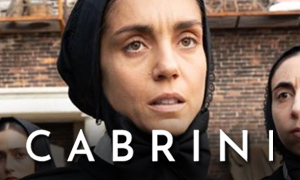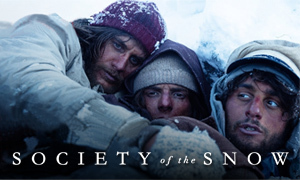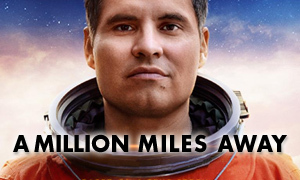Big Eyes: History vs. Hollywood
based on American painter Margaret Keane and her husband Walter Keane
| REEL FACE: | REAL FACE: |
Amy Adams
Born: August 20, 1974 Birthplace: Vicenza, Veneto, Italy | Margaret Keane (born Peggy Doris Hawkins)
Born: September 15, 1927 Birthplace: Nashville, Tennessee, USA |
Christoph Waltz
Born: October 4, 1956 Birthplace: Vienna, Austria | Walter Keane
Born: October 7, 1915 Birthplace: Lincoln, Nebraska, USA Death: December 27, 2000, Encinitas, California, USA |
Delaney Raye
Born: circa 2004 | Jane Ulbrich
Born: April 15, 1950 |
Jon Polito
Born: December 29, 1950 Birthplace: Philadelphia, Pennsylvania, USA | Enrico Banducci
Born: February 17, 1922 Birthplace: Bakersfield, California, USA Death: October 9, 2007, San Francisco, California, USA (kidney and heart problems) |
Terence Stamp
Born: July 22, 1938 Birthplace: Stepney, London, England, UK | John Canaday
Born: February 1, 1907 Birthplace: Fort Scott, Kansas, USA Death: July 19, 1985, New York City, New York, USA (pancreatic cancer) |
Did Margaret and Walter really meet at an outdoor art exhibition in San Francisco?
Yes. The Big Eyes true story reveals that Margaret Hawkins met Walter Keane at an outdoor art fair in San Francisco in the spring of 1955. The real Margaret and Walter have very different memories of their first meeting. In his 1983 memoir, The World of Keane, Walter, who even then was still trying to sell the big eyes lie, says that upon meeting, Margaret told him she loved his big-eyed paintings and that he was the "greatest" and "most handsome" artist she had ever seen. -The Guardian
Had Walter Keane really been a real estate salesman?
Yes, as stated in the movie, Walter Keane had been a real estate salesman, handling properties in Berkeley, California.
Did Walter really try to peddle Parisian street scenes as his own?
Yes, and like in the Big Eyes movie, it was some time later that the real Margaret Keane discovered that Walter wasn't the artist behind the street scenes he had been peddling when they met at the art fair. -TIME.com
Did Walter really sell Margaret's paintings at a club?
Yes. The Big Eyes true story confirms that the real Walter Keane sold his wife Margaret's paintings at his favorite 1950s San Francisco beatnik club, The Hungry i. As in the movie, it was there that she discovered Walter was taking credit for her work. "...he was over there, talking, selling paintings," says Margaret, "when somebody walked over to me and said: 'Do you paint too?' And I suddenly thought - just horrible shock - 'Is he taking credit for my paintings?'" -The Guardian
Did Walter use a brawl with a nightclub owner to help sell the paintings?
This part of the movie is mostly true. In 1958, Walter Keane got into a fight with Enrico Banducci, the owner of The Hungry i nightclub on Jackson Street in San Francisco. Banducci threw a punch at Walter for "using obscenity in the presence of ladies," as The Chronicle worded it. Banducci's punch missed Walter and struck a woman, Nadine Ulrich, in the collarbone. Walter was arrested for drunkeness. The injured woman, Nadine, sued Banducci, and both Walter and Banducci sued each other over the fight. However, it is not known whether Walter and Banducci sued each other intentionally for publicity, as the movie implies.
Is the San Francisco gossip columnist and narrator, Dick Nolan, based on a real person?
Yes. "What's funny is he came from our initial research," says screenwriter Larry Karaszewski. "We kept on finding all these quotes from Walter Keane in this gossip column in San Francisco and we had never even heard of this gossip column before … He made it his beat and his column is a hoot and he was obsessed with Walter, and Walter realized it was a way to plug his business, so Walter would supply him with one quote after another..."
Despite being loosely based on San Francisco Examiner columnist Dick Nolan, fellow screenwriter Scott Alexander says that much of the character's persona was inspired by the suit-wearing, cocktail-drinking journalists and press agents seen hustling each other in the 1957 Burt Lancaster/Tony Curtis movie The Sweet Smell of Success. -TheSource.com
Did Walter Keane really tell people the paintings were inspired by war-ravaged children he had observed in Europe?
Yes. In describing what inspired him to paint big-eyed children, American Walter Keane talked of his supposed time in Europe following WWII, starting in Berlin in 1946. Like in the movie, he told stories of the big-eyed, lost children fighting over scraps of food from the garbage, which broke his heart. He once wrote, "As if goaded by a kind of frantic despair, I sketched these dirty, ragged little victims of the war with their bruised, lacerated minds and bodies, their matted hair and runny noses. Here my life as a painter began in earnest." While Walter might have seen downtrodden, unhappy children in postwar Europe, he completely lacked the skill to paint them. -The Guardian
In speaking about the characteristic big eyes given to the children in the paintings, Walter told LIFE Magazine, "Nobody could paint eyes like El Greco and nobody can paint eyes like Walter Keane."
What inspired Margaret Keane to paint the big-eyed waifs?
"Those sad children were really my own deep feelings that I couldn't express in any other way," said Margaret Keane in a 2014 interview with The Guardian. "I was actually putting my own feelings into that child I was painting" (Big Eyes Featurette). In the movie, Amy Adams character reasons that she paints the eyes big because the "eyes are the windows to the soul," a sentiment that the real Margaret Keane has echoed herself.
"Children do have big eyes," says Margaret. "When I'm doing a portrait, the eyes are the most expressive part of the face. And they just got bigger and bigger and bigger." -SFGate
Why did Margaret Keane go along with the lie?
When Margaret Keane discovered Walter was taking credit for her paintings that he was selling at The Hungry i beatnik club, they were two years into their marriage and had been happy until that point. Margaret says that Walter told her, "We need the money. People are more likely to buy a painting if they think they're talking to the artist. People don't want to think I can't paint and need to have my wife paint. People already think I painted the big eyes and if I suddenly say it was you, it'll be confusing and people will start suing us." -The Guardian
As to why she didn't sell the paintings herself, Margaret told LIFE Magazine in 1970, "Every night Walter went down to sell the paintings at a San Francisco night spot called The Hungry i. I stayed home painting a lot of children with different city backgrounds. It suited me fine. I was extremely timid and shy."
"Back then, women kind of went along with their husbands, didn't rock the boat," Margaret says. "He finally wore me down. While we were fighting this out at home, the paintings were just flying off the walls. Posters were selling. It was unbelievable. It snowballed overnight. I kept getting in deeper and deeper. ... I lost all respect for him and myself, and lived in a nightmare." -SFGate
Did Walter ever try to paint the big eyes himself?
The movie implies that Walter never tried to paint himself. This is not true. In order to appease Margaret and make up for his lie, the real Walter Keane asked her to teach him how to paint the big-eyed children. She attempted to instruct him, but says "it was just impossible." Walter told her she wasn't teaching him right. She wanted to leave him then but didn't know how she would support her daughter. -The Guardian
Were the big-eye paintings really as popular as they are in the movie?
Yes. In researching the true story behind the Big Eyes movie, we discovered that the popularity of the big-eye paintings soared when the Keanes started to mass produce the images for sale as posters, on postcards, china plates, refrigerator magnets, etc., making the art affordable to the masses. It was also available at mainstream locations like supermarkets and gas stations. A 1965 LIFE Magazine story called the paintings "the most popular art now being produced in the free world."
Did they really move into a big house with a pool?
Yes, and like in the Big Eyes movie, Margaret says that she was painting sixteen hours a day in a room with the curtains closed and door locked. As in the movie, not even her daughter or their staff were allowed in. She describes Walter as jealous and domineering, saying that he wouldn't let her have any friends. This is somewhat conveyed in the movie when he kicks out her friend Dee-Ann (Krysten Ritter), who had come to visit. If he was out, he'd call every hour to make sure she was still there. If she did slip out, he would follow her. Like in the movie, celebrities did visit the Keane pool, including The Beach Boys, but Margaret rarely met them since she was almost always painting.
According to Walter's memoir, he was having affairs at the time. "Everybody was screwing everybody," he wrote. "Sometimes I'd be going to bed and there'd be three girls in the bed." Though Margaret doesn't deny Walter was unfaithful, she has not explicitly supported some of the more boastful claims in his memoir.
Is Krysten Ritter's character, Dee-Ann, based on a real person?
No. As we investigated the Big Eyes true story, we learned that Margaret's friend in the movie, Dee-Ann, is a composite. Screenwriter Scott Alexander states, "We made up a composite friend character for Margaret: Dee-Ann, played marvelously by Krysten. She represents the new, '60s woman and she's not afraid to speak her mind." His writing partner, Larry Karaszewski, adds, "Dee-Ann is that voice that's trying to steer Margaret in the right direction." -Big Eyes Production Notes
Did Walter really threaten to have Margaret killed?
Yes. According to the Big Eyes true story, Margaret says that Walter told her, "If you ever tell anyone, I'm going to have you knocked off" (The Guardian). He made this threat more than once, and only after his death in 2000 did she stop living with a certain degree of fear. "Not until he died did I really feel that I wasn't going to be knocked off," says Margaret. "I don't like to hear people die but it was a relief that I didn't have that fear anymore" (UPI). She says that he tried to hit her once, but she threatened to leave him if he ever tried it again. However, she did give away their chihuahua to protect it from Walter after he kicked it.
Did she really have a month to paint a masterwork for the 1964 World's Fair?
Yes. The painting, which is depicted in the movie, became known as "Tomorrow Forever." It featured a hundred big-eyed children of many different nationalities. It was hung in the Pavilion of Education at the 1964 World's Fair in New York City. -The Guardian
Did art critic John Canaday really bash Margaret's World's Fair painting?
Yes. Portrayed by Terence Stamp in the Big Eyes movie, art critic John Canaday wrote such a scathing review of Margaret's "Tomorrow Forever" painting that the World's Fair decided to take it down. "This tasteless hack work contains about 100 children and hence it is about 100 times as bad as the average Keane," wrote Canaday in The New York Times.
Did Walter really confront the art critic and try to stab him with a fork?
No. The New York Times art critic John Canaday did pan the 1964 World's Fair "Tomorrow Forever" painting and wrote that Keane "grinds out formula pictures of wide-eyed children with such appalling sentimentality that his product has become synonymous among critics with the very definition of tasteless hack work." However, there is no evidence that Walter tried to stab Canaday with a fork like Christoph Waltz's character does in the movie.
Did Walter Keane nearly burn down their Woodside, California home?
In the movie, we see Christoph Waltz's character flicking matches at Margaret (Amy Adams) and her daughter Jane (Madeleine Arthur). He then shoves burning matches through the keyhole of Margaret's studio, which ignite a spilled can of turpentine. Court documents reveal that Walter made threats "to burn the house down and kill her if she tried to leave him."
For how long were Margaret and Walter Keane married?
They were married for roughly ten years before divorcing in March of 1965. Margaret then married her third husband, Honolulu sportswriter Dan McGuire, in 1970. McGuire is not included in the film. -BigEyesFilm.com
Did Margaret really continue to paint for Walter after the divorce?
Yes, like in the Big Eyes movie, Margaret continued to secretly paint for Walter after she went to Hawaii. She sent approximately 20 or 30 big eyes to him over the course of five years before she decided to end the lie, making a promise to herself to always tell the truth from then on. -The Guardian
Did Margaret Keane really reveal the truth during a radio interview?
Yes. Margaret revealed the truth during an October 1970 interview with a San Francisco radio talk show (not a Hawaiian radio show). This was more than five years after she and Walter had separated. She intended to discuss her art show at the Cory Art Gallery in San Francisco, but she ended up coming clean after the host began to ask about her ex-husband Walter. -UPI
In November of 1970, Margaret challenged Walter to a paint-off in Union Square in San Francisco, but Walter never showed. Instead, he countered her invitation by saying she was a "boozing, sex-starved psychopath." -LIFE Magazine
Did Walter actually cross-examine himself during the 1986 trial?
Yes. "Walter actually did that in the trial," says Big Eyes screenwriter Larry Karaszewski. "He actually did cross-examine himself. He was his own lawyer. He did so much that we actually had to pull back a bit. A judge threatened to put duct tape over his mouth" (Big Eyes Featurette). It should be noted that the trial in the movie happens closer to when the Keanes were still in the limelight. In real life, the trial took place in 1986 when Margaret and Walter were a bit older, and Margaret's daughter Jane was an adult.
Did Margaret and Walter really have a paint-off in court?
Yes. In 1986, Margaret sued Walter for $3 million for slander. The case was heard in Honolulu federal court and lasted three-and-a-half weeks. Like in the movie, Walter acted as his own attorney and the judge challenged both of them to paint a child with big eyes. In 53 minutes, Margaret painted a little boy with huge eyes, staring nervously from behind a fence. As depicted in the movie, the painting became Exhibit 224. As for Walter, the movie is accurate. He said that he couldn't paint because he had a sore shoulder.
Margaret was awarded $4 million but never saw a dime of it because Walter was broke. He had spent years withering the fortune away on alcohol, drinking from morning until night, living in a fisherman's shack in La Jolla, California. -The Guardian
Did Margaret Keane really become a Jehovah's Witness?
Yes. Like in the Big Eyes movie, Margaret became a Jehovah's Witness in the late 1960s after leaving her husband Walter and moving to Hawaii to start fresh. -SFGate
Did Walter Keane ever admit that Margaret painted the big-eyed paintings?
No. Walter adamantly denied his ex-wife's claims until his death at 85 on December 27, 2000.
Why does Margaret Keane sign her paintings "MDH Keane"?
Her maiden name is Margaret Doris Hawkins (née Peggy Doris Hawkins). She started including the "MDH" after coming clean about being the artist.
Does the real Margaret Keane have a cameo in Big Eyes?
Yes. The real Margaret Keane has a cameo in the Big Eyes movie. "I'm a little old lady sitting on a park bench," says Margaret. -The Guardian
What made director Tim Burton want to tell Margaret Keane's story?
Big Eyes director Tim Burton has collected Margaret Keane's artwork for years. In the 1990s, he commissioned her to paint a portrait of his then-girlfriend Lisa Marie Smith, an American model and actress. -The Guardian
Who are some of the famous people Margaret Keane has painted?
Numerous celebrities have posed for Margaret Keane, including Natalie Wood, Kim Novak, Robert Wagner, Joan Crawford (pictured), Liberace, Zsa Zsa Gabor, Dean Martin, Jerry Lewis, Helena Bonham Carter, Adlai Stevenson, and John and Carolyn Kennedy. -BigEyesFilm.com
Margaret and Walter Keane Interviews
To further expand your knowledge of the Big Eyes true story, watch the Walter Keane interview below. Then check out a Margaret Keane interview in which she discusses Walter's death threats and her own remorse for going along with the lie.
WATCH Walter Keane Interview - Merv Griffin Show 1966This Big Eyes movie featurette
features a 1966 Walter Keane interview
from The Merv Griffin Show. When
asked why the children are so sad-eyed and
lost looking, Walter Keane replies, "Well,
I started painting children like this in
Berlin after the war." Walter then
proceeds to hit on another female guest on
the show. This interview is the only known
video footage of Walter Keane. |
WATCH Margaret Keane InterviewThis Margaret Keane interview features the
87-year-old artist discussing painting,
her inspiration for the big-eyed waifs,
and her ex-husband Walter Keane. She says
that she "wasn't very strong" and
describes her situation with Walter as
being a "total nightmare." She says that
living with the lies was a "horrible"
experience that was "tearing me apart." |
WATCH Big Eyes TrailerTim Burton directs Amy Adams and Christoph
Waltz as Margaret and Walter Keane, an
American painter and her husband, who
tried to take credit for her work. In the
movie, their divorce battle reaches a
climax in a courtroom where a judge puts
up two easels, side by side, and asks each
of them to paint one of the famous
big-eyed paintings. |
Link-to-Learn More:
- Keane Eyes Gallery - Where Margaret Features Most of Her Work
- Margaret Keane Art on Pinterest - Browse Hundreds of Keane Images
- Big Eyes Selfie Portrait - Customize a Photo to Give Yourself Big Eyes
- Big Eyes Official Movie Website







